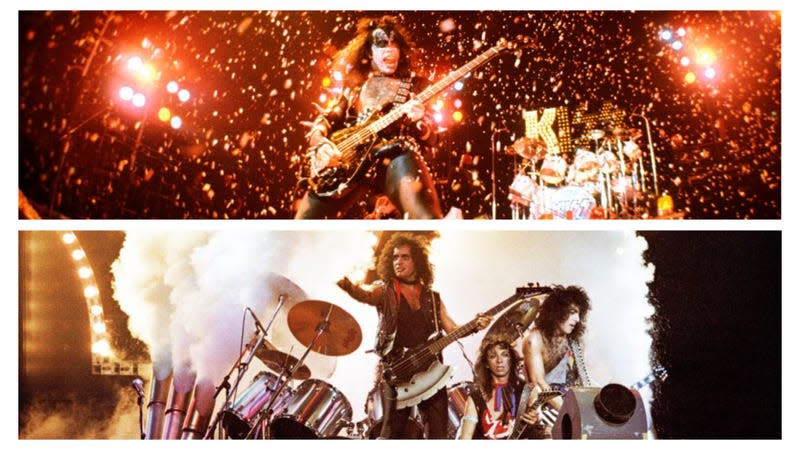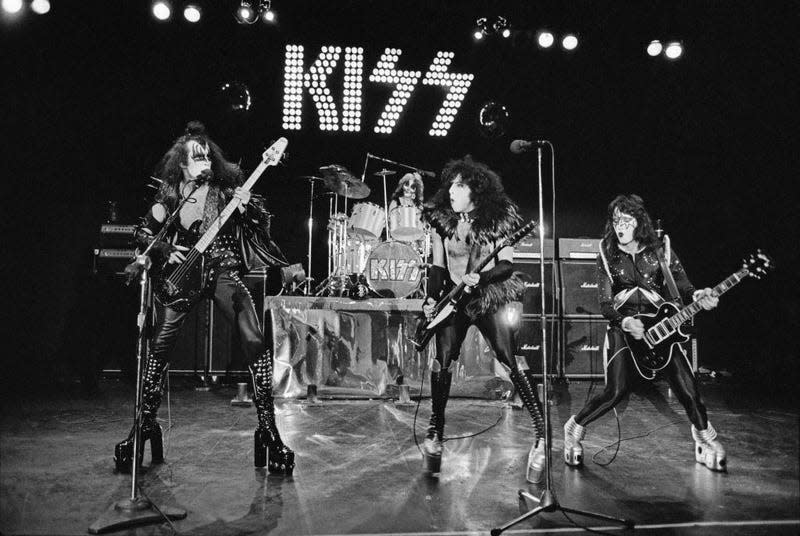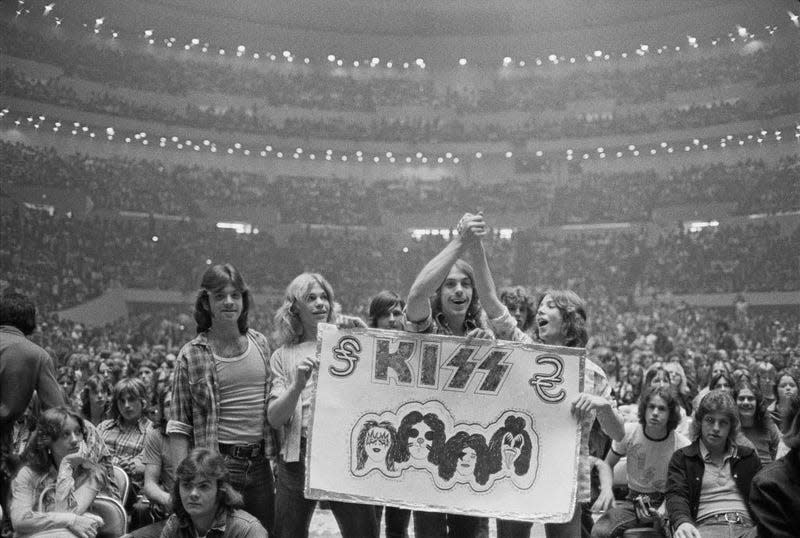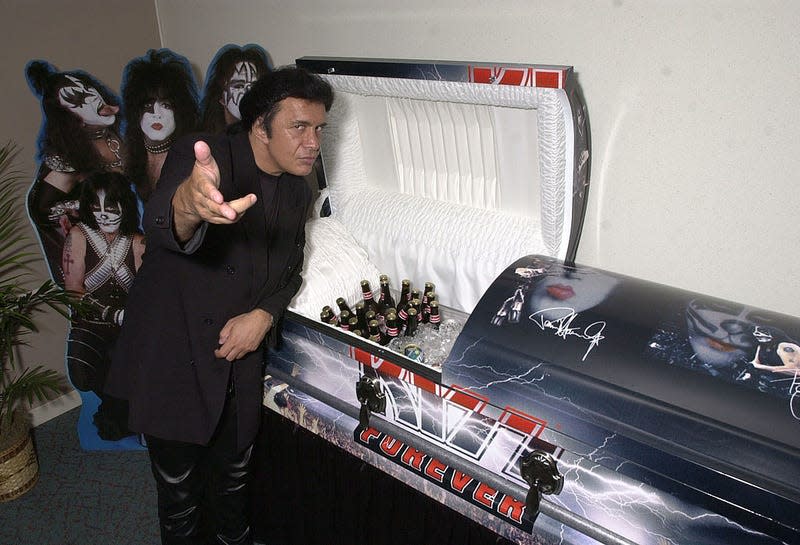KISS at 50: The band's 25 most remarkable moments

- Oops!Something went wrong.Please try again later.
- Oops!Something went wrong.Please try again later.
- Oops!Something went wrong.Please try again later.
- Oops!Something went wrong.Please try again later.
Fifty years ago this month, KISS arrived on the scene with their eponymous debut album, kicking off a career that would see the band become as well known for their kabuki face paint and outlandish outfits as they would be for their hit songs and their flashy live shows. Of course, KISS can’t be seen as a conventional rock band. Sure, they’ve sold millions of albums, reaching the Billboard Top Ten several times in their long career, but reducing KISS to their discography underestimates their influence: they were the first multimedia rock band, sensing the potential of Saturday morning television, comic books, and variety shows—pop culture territories that most other rockers vigorously avoided.
To get a sense of KISS’s impact, you don’t need a list of their best songs or albums: you need a list of their best moments, a combination of music, media, and marketing that made the band indelible. Gene Simmons and Paul Stanley—who led KISS through all its incarnations until the group’s farewell concert last year—were notoriously savvy businessmen, keeping the KISS brand alive throughout the 21st century. Although KISS has made many appearances—they happily accepted seemingly any animated show that came their way, popping up on not one but two Scooby-Doo specials—this list generally concentrates on material from their ’70s rise and ’80s fall, when the band could be seen mixing it up with Hollywood legends and battling bad guys in the pages of a comic book.
25. Avatars (2023)
At the close of the group’s (allegedly) final concert at Madison Square Garden in New York City last year, KISS unveiled their next chapter. As Paul Stanley proclaimed over the PA, “The end of this road is the beginning of another road. We’re not going anywhere! You’ll see us in all different things, all the time. See you in your dreams!” The stage revealed digital avatars playing “God Gave Rock and Roll To You II,” signaling that even though Stanley and Simmons may finally be too old for the road, they’ve found a way to keep the party going long after they’ve retired … and possibly after they’ve shuffled off this mortal coil.
24. MTV Unplugged (1996)
Aware that KISS needed a strong hook for their 1996 appearance on MTV Unplugged, Gene Simmons and Paul Stanley drafted Peter Criss and Ace Frehley to reunite for a handful of songs in the midst of a set that also featured then-current guitarist Bruce Kulick and drummer Eric Singer. Acoustic sets aren’t normally associated with KISS, but the original chemistry was so evident—and so celebrated—that the original lineup of Simmons, Stanley, Criss, and Frehley headed out on the road later that year, launching their tour at Detroit’s Tiger Stadium.
23. “Hard Luck Woman” (1976)
As good a rip-off of Rod Stewart as Bonnie Tyler’s “It’s A Heartache,” “Hard Luck Woman” replicates the ramshackle folk-rock of “Maggie May.” The connection is underscored by Peter Criss singing with a ragged edge, one that’s reminiscent of Stewart’s soulful rasp, resulting in an enjoyable anomaly in the KISS catalog: for a brief moment, they seem like a loose roots-rock band.
22. Detroit Rock City movie (1999)
Arriving at the end of the 1990s, a decade steeped in 1970s lore, Detroit Rock City tells the tale of a KISS tribute band attempting to see their heroes at the Cobo Arena in Detroit—the famed location where the band recorded KISS Alive. Featuring Edward Furlong, Melanie Lynskey, and Natasha Lyonne, the tasteless comedy didn’t find an audience when it hit theaters late summer of 1999, but it was a kindred spirit to that year’s bawdy teen comedy American Pie.
21. Solid Gold appearance (1981)
The natural place for KISS to promote a fantasy concept album is, of course, Solid Gold, the Top 40 countdown show famed for its dance troupe. After being introduced by Andy Gibb, KISS amiably mimed “I,” a full-tilt rocker that seemed painfully out of place in the glitzy surroundings of Solid Gold—and the situation wasn’t improved when ventriloquist Marty Cohen and his puppet Madame both showed up in KISS regalia to introduce “World Without Heroes.”
20. Tom Snyder’s Tomorrow Show (1979)
Plugging their disco-fied album Dynasty, KISS joined Tom Snyder’s late-night gabfest The Tomorrow Show. Their booking was not unusual. Snyder often found space for all kinds of rockers on his show, and KISS enthusiastically accepted any TV offer that came their way. What was unusual is that the panel featured the full band, notably a hammered Ace Frehley who dominated the interview with his drunken interjections—much to the chagrin of Stanley, who was still harboring a grudge as late as 2012, claiming that it showed “a contempt and a lack of respect for the audience and the fans.”
19. “Christine Sixteen” (1977)
“Christine Sixteen” may have been the sleaziest of the singles that cracked the Top 40 in the wake of Alive! and Destroyer. An unabashed celebration of teenage lust, it’s sung with an audible grin with Gene Simmons, but the key to the single’s success is that it’s not a balls-out rocker: it has a sly groove that’s so funky, it wound up being sampled by Tone Loc on his hit “Funky Cold Medina.”
18. CREEM writer Jaan Uhelszki joins KISS onstage (1975)

The lone advocate for KISS at the Detroit-based rock magazine CREEM, Jaan Uhelszki flashed upon a brilliant idea for a feature: she’d join KISS onstage for a night, so she could see what it felt like on the other side of the typewriter. Donning her own version of KISS makeup as well as an unplugged red Fender, she sang “Rock and Roll All Nite” with KISS, as well as members of Rush. Few other rock bands would’ve accepted the challenge—really, only J. Geils Band, who had CREEM’s Lester Bangs onstage to bash out a review as the band rocked—which speaks well to both KISS and Uhelszki.
17. “Shout It Out Loud” (1976)
The first single pulled from Destroyer, the 1976 record where KISS struck up a fruitful collaboration with producer Bob Ezrin, “Shout It Out Loud” is (very) loosely based on an old Hollies tune Paul Stanley and Gene Simmons covered in Wicked Lester, a group they had before forming KISS. This hardly seemed like a British Invasion holdover: it was all big beats and primal guitars, a song made for the decadent airwaves of the mid-1970s.
16. Paul Lynde Halloween Special (1976)
Hot on the heels of the twin successes of KISS Alive and Destroyer, KISS accepted an appearance on The Paul Lynde Halloween Special, which was produced by Sid and Marty Krofft, the masterminds of mind-bending ’70s kids entertainment. The Kroffts enlisted their creation Witchypoo to appear alongside Tim Conway, Betty Conway, Billy Barty, and Margaret Hamilton, who revived her role as the Wicked Witch of the West from The Wizard Of Oz. In this context, KISS playing “Beth” and “Detroit Rock City” seemed relatively normal.
15. KISS pinball machine (1979)
Right in the thick of KISS mania, Bally introduced a KISS pinball machine in 1979—further proof of the band’s monumental reach in pop culture. The machine kicked around into the 1980s, popping up in such films as Psycho III and Friday The 13th Part 2, building a legacy that laid the groundwork for a new KISS pinball machine to appear in 2015.
14. KISS (1974)
The band’s eponymous 1974 debut album, KISS, may be a bit slick and stiff in parts, but it established the group’s basic template of spirited sleaze with the occasional glimpse of reflection. The latter came in the form of “Black Diamond,” a sketch of sex workers walking the streets of New York City which the Replacements later covered on Let It Be, one of the seminal records of 1980s underground rock. Still, what really resonated were “Strutter” and “Deuce,” unabashed rockers that captured the band’s eager hunger.
13. KISS action figures (1978)
KISS deliberately styled themselves as comic book heroes, so perhaps it was inevitable that the group would become action figures themselves. That’s what happened in 1978, when Mego marketed giant dolls of Paul, Gene, Peter, and Ace, promoting the figures with a breathless ad that played nonstop on Saturday morning TV.
12. Music From The Elder (1981)
Sensing a brewing rebellion from hardcore fans unhappy with the band’s brazen embrace of bubblegum pop and disco in the late 1970s, KISS reunited with Destroyer producer Bob Ezrin to get back to basics. That’s not where they wound up with Music From The Elder. Shortly into the project, the group conceived a concept album set in mystical elden times, a theme that quickly got garbled.
11. The Kiss Army (1975-)

Unlike many elements in the KISS expanded universe, The Kiss Army had organic beginnings. A pair of fans from Terre Haute, Indiana, started the fan club in 1975, but the band soon took over the organization, turning it into a long-running official club with the Destroyer album. At its peak, the club had around 100,000 members, and while it dwindled away sometime in the 1980s, the band relaunched the fan club in the late 2000s, recruiting Secretary of State Condoleezza Rice as a notable new member.
10. “Beth” (1976)
KISS’s only Billboard Top Ten hit, the deliberately sappy “Beth,” was the brainchild of drummer Peter Criss, who sang the song as a tentative, tender plea. His quivering delivery was overwhelmed by the symphonic pomp orchestrated by producer Bob Ezrin, who turned this sweet, simple number into a bombastic power ballad.
9. Kiss Kasket (2001)

Bedecked in the KISS logo and portraits of the group, the KISS Kasket was designed for the hardcore fan who wanted to take their favorite band with them into the great beyond. One of those fans was Pantera guitarist “Dimebag” Darrell Abbott, who requested to be buried in a KISS Kasket in his will. After his 2004 murder, Gene Simmons donated his personal casket to Abbott’s family. Not everybody who purchased the Kiss Kasket had such immediate needs for the item, so the band made sure that it was waterproof, so it could double as a massive cooler for your next beer bash.
8. “I Was Made for Lovin’ You” (1979)
Coming within spitting distance of Billboard’s Top Ten, “I Was Made for Lovin’ You” found KISS shamelessly riding the disco bandwagon of the late 1970s. KISS was hardly the first to fuse rock and disco—Rod Stewart and the Rolling Stones both got there first—but the group’s zeal at co-opting the fashion of the time gave “I Wade Made for Lovin’ You” a trashy kick that made it one of the group’s very best singles.
7. Rock & Roll Hall of Fame induction (2014)
The KISS Army lobbied for the band’s inclusion into the Rock & Roll Hall of Fame for years, forcing the institution to launch the fan ballot in 2012. Two years later, the Hall succumbed to fan pressure and accepted KISS into the institution, a testament to the enduring connection between the group and its audience.
6. The Unmasking/“Lick It Up” (1983)
KISS faced an uphill battle in 1983. Not even a decade into their career, the group was seen as has-beens, hobbled by their hubris and wounded further by shifting styles—disco and punk had passed, New Wave was on the rise—they had one card left to play: they took off their makeup. Promoted with an interview on MTV, the great unmasking was accompanied by the video to “Lick It Up” which featured their faces sans kabuki makeup.
5. Kiss Meets The Phantom Of The Park (1978)
Riding high on their stardom, KISS teamed with Hanna-Barbera to make the TV movie KISS Meets The Phantom Of The Park, an absurd tale of the band battling a fiend intent on sabotaging an amusement park. Culminating in a ludicrous sequence where the band battles robotic incarnations of themselves, the film was immediately regarded as a mistake by the band—legend has it, they forbid its mention for years—but fans flocked to its sheer lunacy, cherishing the band’s awkward performances.
4. A Marvel Comics Super Special!: KISS (1977)
KISS wasn’t the only rock band to be granted a special issue by Marvel—the Beatles would make an appearance later in this line—but they were a natural fit for a comic book since they intentionally styled themselves as heightened personas. The 1977 comic found the band triumphing over Doctor Doom and Mephisto, setting the stage for their real-life Hanna-Barbera film KISS Meets The Phantom Of The Park. But KISS found a way to retain an appearance of danger in these kiddie-friendly surroundings: they had their own blood mixed into the red ink used in the comics.
3. Solo albums (1978)
The peak of KISS madness is also when they decided to go solo. All four members released self-titled records in September 1978, a tactic that they later claimed was due to rising tensions in the band, but is likely the result of the band’s biggest desire: they wanted to conquer the marketplace by any means necessary. That didn’t quite pan out, as the four simultaneously released records diluted the band’s mystique. Best among these was either Gene Simmons’ ambitious effort with its oddly sincere version of “When You Wish Upon A Star” or Ace Frehley’s straight-ahead rock record, highlighted by the stomping “New York Groove.”
2. “Rock And Roll All Nite” (1975)
Written as a response to Neil Bogart telling the group they needed “an anthem” for their third album Dressed To Kill, “Rock And Roll All Nite” fulfilled the wishes of the band’s label head. A rallying call for non-stop partying, “Rock And Roll All Nite” wasn’t just a rousing arena-rocker, it was a manifesto, distilling the band’s gleeful hedonism into a supersonic blast.
1. Alive! (1975)
Appearing at the end of 1975, Alive! crystalized the appeal of KISS, cherry-picking the best songs from their first few albums and giving them sinewy renditions that easily eclipsed the frequently stilted original studio versions. Here, KISS sounded as if they couldn’t be contained on a stage: they were larger than life, happily offering their rock & roll thrills with lurid theatricality—a combination that was simultaneously dangerous and silly, a blend that became their enduring signature.

